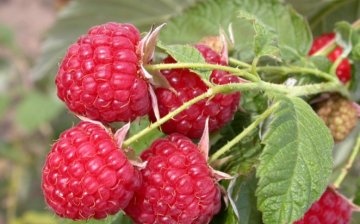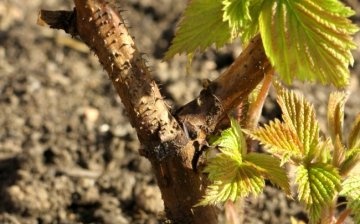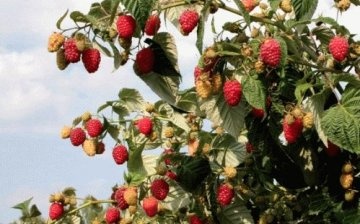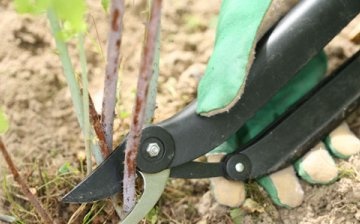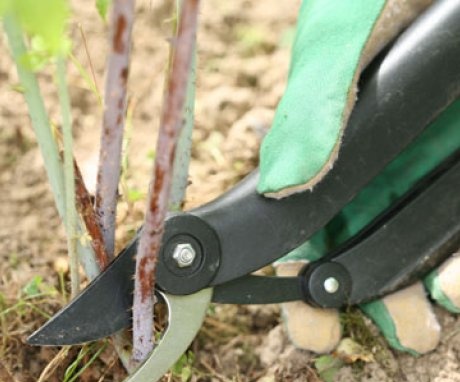Pruning remontant raspberries: rules and tips
Repaired raspberries are in special demand among professional gardeners and amateur gardeners. And this is no coincidence! The berries of this shrub have excellent taste, and besides, they hang on the branches almost all summer. The remontant raspberry varieties are zoned to many regions of the temperate climate of our country. But pruning and growing this shrub must follow certain rules.
Content:
Growing raspberries remontant
Shrubs of remontant raspberry have an excellent aesthetic appearance, and its berries have an excellent taste. Raspberry fruits are quite large in size, sweet and remain on the bush until autumn. But in order to enjoy such a bountiful harvest of berries, you should work a little in the spring, since the cultivation of this shrub requires special care.
Raspberry remontant is a fairly light-loving plant, so it should be placed in areas of the garden, with abundant sunlight.
In addition the plant is demanding on the amount of moisture in the soil, therefore, during the summer, if there is little rainfall, raspberries should be provided with additional watering.
Plant feeding:
- During the growing season, the shrub must be fed, since a huge amount of substances is needed for the formation of large berries.
- Top dressing should be done observing the concentration of the selected fertilizer, otherwise the desired result may not be achieved.
If all these rules are followed, then you will have a bountiful harvest of raspberries until autumn. Despite the effort spent and the time taken to care for the shrub, the expected result is much more pleasant than the effort spent.
The best time that is favorable for planting this shrub in the climate of our country is September, or rather the period from the twentieth to the end of the month. During this period, the weather is rather warm, as it coincides with the "Indian summer". The planted saplings of remontant raspberries during the warm stage of autumn have time to take root in the soil and accumulate the necessary substances for the period of winter dormancy. In the conditions of little snow or frosty Russian winter, the substances accumulated in the fall help the shrub to survive the cold. After overwintering, the remontant raspberry in the spring immediately begins an active growth process. Seedlings of raspberry remontant they are planted not earlier, since their roots have not yet matured, and the whole plant may die.
You can also plant remontant raspberries in early spring. To do this, you should:
- Dig in the necessary bushes of the plant, tilting slightly to the side before the winter period. But in this case, at first the plants will not actively grow, but will strengthen their root system and gain strength.
- Some gardeners plant remontant raspberries even at the end of winter or early summer, but in this case, the previously necessary seedlings should be kept under a snow layer for some time.
- This event will allow the plant to create the conditions for the necessary rest before spring, during which the plants will gain the strength necessary for growth.
- The layer of snow, which should cover the seedlings, is sprinkled on top with sawdust or dry straw.Such conditions will allow the snow to last longer in the warm spring conditions.
For the climate of our country, breeders have bred several varieties of remontant raspberries, confined to each climatic region of its growth. Therefore, it is better for amateur gardeners to use for planting those varieties that are adapted to the conditions of a given area. So, for example, the inhabitants of the northern regions of a temperate climate are best suited for raspberry plants, characterized by rapid growth and accelerated ripening of berries.
The seedling planting algorithm begins with the preparation of a small depression or hole to accommodate all the roots in it.
In the prepared turnout, you need to place some fertilizer, in order to accelerate the growth of the root system. Then a shrub is placed in the hole and its roots are buried. The top layer of soil should be tamped a little so that the plant is kept upright, and animals and birds cannot dig out its roots. The established and rammed seedling should be watered abundantly with water.
Raspberry care
Caring for remontant raspberry bushes should be in accordance with the following rules:
- Shrubs should be mulched in order to avoid the appearance of an abundant amount of weeds on the soil surface and near the stem.
- Watering is necessary during the fruiting period and in dry summer conditions. You should not loosen the soil near the remontant raspberry bush, as you can damage its surface roots, which will slow down the growth of the plant.
- Top dressing should be done with special fertilizers containing a complex of nutrients for remontant raspberries. The most favorable time for feeding is March. A well-done top dressing will help not only nourish the plant, but also form a bountiful harvest of large berries. Fertilizers such as superphosphate and potassium sulfate are the best in terms of nutritional value.
- In order to prevent the development of various diseases on seedlings, including those of a fungal nature, plants need to be processed bordeaux liquid. Such an event should be held in April. To prevent the appearance of pests on shrubs, the entire remontant raspberry plant during the flowering period must be treated with special biological products.
- A special measure for the care of remontant raspberry seedlings is pruning the shoots. It is on its correct implementation that sometimes not only the future harvest depends, but also on this in the growth of the entire plant.
Pruning raspberry remontant
Raspberry remontant begins to bear fruit already in the second year of the life of its shoots. This stage of the emergence of berries is very convenient for gardeners, since they do not have to wait long for the harvest. The first harvest is especially large and plentiful, when the plant spends all its energy to form and ripen.
Further, the plant begins to direct all its forces to the formation and growth of replacement shoots, on which the second harvest will subsequently ripen. Under such conditions of growth and distribution of forces of remontant raspberry special cutting technology needed her shoots.
At the stage of the first year of life, remontant raspberry bushes form young shoots.
Over time, they become covered with flowers, usually not earlier than July. Following the flowers, berries begin to form on the shoots - by August.
Raspberry Pruning Secrets:
- Shoots of the first year of life should not be left for the next year. Experienced gardeners recommend cutting them up to three centimeters above the soil surface. All annual shoots should be trimmed. This should be done in early October until mid-November. During this period, the plant no longer contains berries on its shoots.
- Autumn pruning of remontant raspberry plants is carried out not only in order to increase the future yield.This event helps to protect all raspberry bushes from the negative effects of viral and parasitic organisms that can hibernate on the shoots. In a winter with little snow, short raspberry stumps are easy to insulate, which will allow the plant to survive the winter cold.
- In spring, remontant raspberry plants are cut to the level of the first healthy bud. Shoots frozen in winter are pruned. This event is best done in April.
More information can be found in the video.



